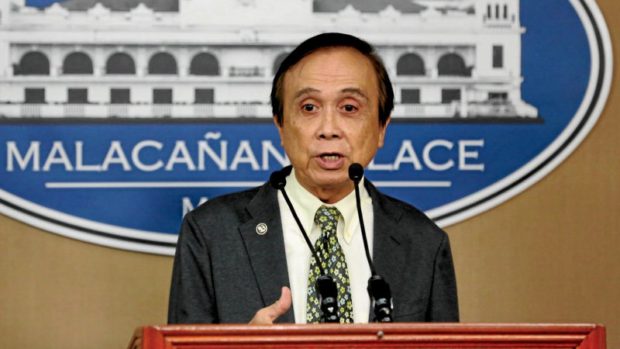Inflation hits 5-month high of 3.4% in September

Socioeconomic Planning Secretary Ernesto M. Pernia (File photo by JOAN BONDOC / Philippine Daily Inquirer)
Inflation rose 3.4 percent year-on-year in September, a five-month high, which the government on Thursday mostly blamed on higher food prices due to weather disturbances that month.
The latest Philippine Statistics Authority (PSA) data showed that the rate of increase in prices of basic goods last month matched the 3.4 percent posted in March and April as well as higher than the 2.3 percent recorded in September last year.
In a statement, the state planning agency National Economic and Development Authority (Neda) said food inflation inched up to 3.6 percent in September from August’s 3.5 percent, as prices of bread, cereals, corn, fish, flour, oils and fats, pasta as well as vegetables increased.
“The accelerated adjustments in food, particularly corn, fish, and vegetables, can be partly traced to the lingering effects of typhoon ‘Jolina’ and tropical depression ‘Maring,’ which caused damage to agriculture and fisheries in the Calabarzon region, particularly Quezon province,” Socioeconomic Planning Secretary Ernesto M. Pernia said.
Losses from “Maring” amounted about P77 million, Neda noted.
As such, “we must continue to strengthen the resiliency of communities not only to support low-income farmers but also to stabilize prices of agricultural commodities,” said Pernia, who heads Neda.
“This can be done through programs on increasing access to technology, improving access of agriculture products to trade partners, and upgrading credit programs to include crop insurance so farmers are able to recover from losses,” Pernia added.
Non-food inflation, meanwhile peaked to 3.1 percent, the fastest since February 2013, “due to faster year-on-year price adjustments in housing, water, electricity, gas and other fuels, transport, restaurants, and clothing and footwear,” Neda explained.
“The government needs to closely monitor movements in domestic fuel prices and utility rates. Faster inflation in these sectors will negatively impact the spending capacity of lower-income households for basic necessities like food, and important services such as health and education,” according to Pernia.
As of end-September, headline inflation averaged 3.1 percent, PSA data showed.
“We are still positive that inflation for full year 2017 will settle within the government’s target of 2-4 percent. However, we still face several risks to inflation such as higher domestic fuel prices, weaker peso, and minimum wage hike that will be effective today in the National Capital Region,” Pernia said.
For his part, Bangko Sentral ng Pilipinas Governor Nestor A. Espenilla Jr. said “the BSP remains of the view that the inflation environment will continue to be manageable over the policy horizon after taking into account the latest assessment of price levels in September.”
“Inflation is projected to settle within the national government’s target range of 2-4 percent in 2017 to 2019. Firm domestic economic activity, sufficient liquidity, and well-anchored inflation expectations continue to support current policy settings. However, the BSP will continue to closely monitor emerging economic and financial developments to determine scope for further refinement of policy instruments,” Espenilla said.
In a note to clients, ING Bank Manila senior economist Joey Cuyegkeng said that “the upside inflation surprise may lead to the BSP’s need to turn more cautious if inflation reports for October and November remains on an uptrend.”
“The September inflation rate, together with acceleration in monetary indicators add other indicators that may presage overheating. The other indicators include imbalances in the economy—wider trade deficits, a current account deficit and fiscal deficits, and a positive output gap since 2016,” according to Cuyegkeng.
“We continue to expect that the BSP may need to implement a pre-emptive tightening at the December meeting to head off overheating in the economy. This would also address the need to possibly re-anchor inflation expectations while preserving interest rate differentials (in the wake of a likely Fed rate hike),” Cuyegkeng added. /jpv
